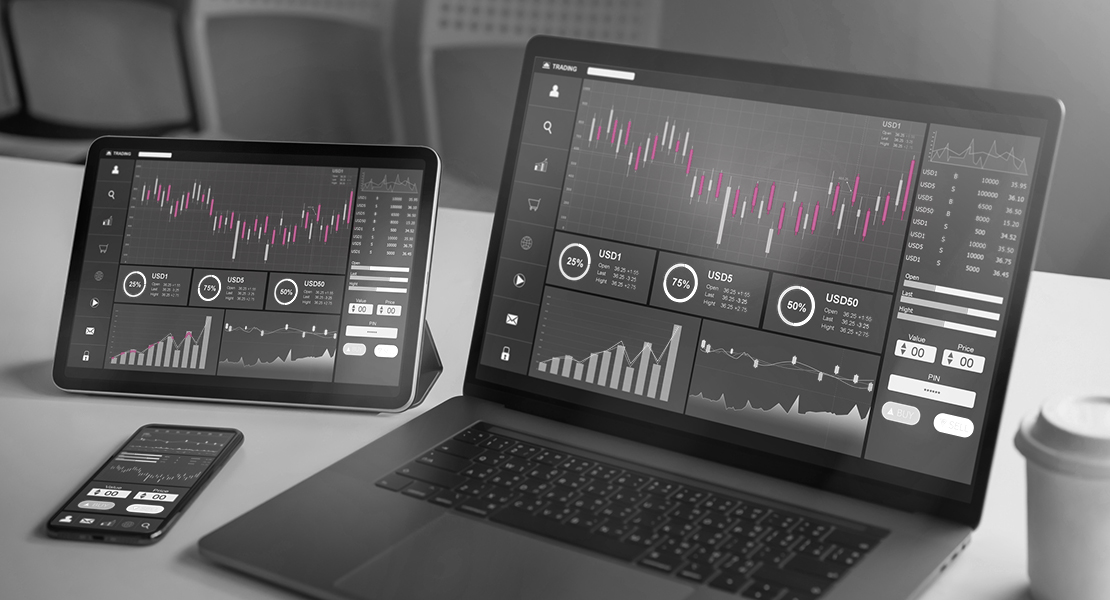The dimension of digitization in all its size and speed is still difficult to grasp. It is a mistake to dismiss it as a mere topic for the IT departments; every manager must be committed to it, especially the finance departments and CFOs. The digitalization of all areas and the resulting availability of a large amount of previously not seizable data allows a much better representation of knowledge about customers and customer satisfaction, as well as brand satisfaction and reputation, in short: intangible assets. Only through knowledge and the correct handling of automated data collected and processed by systems it will be possible in the future to make efficient and future-oriented corporate decisions.
For this, the departments - all departments! - must network better and more flexibly, transform the data into reasonable and meaningful information and constantly check the forecasts generated from it.
From the perspective of the finance departments, we show that increasing digitization has created an acute need for action and how this affects the work within finance departments and in networking with other departments and external partners. In this way, the circles of previous CRM, marketing surveys and financial key figures are connected with the new sources of information such as social networks and user data, which are becoming accessible through the Internet of Things (IoT), cloud based applications or other big data sources such as Google.
Equally relevant is the availability of the right information in real time in edited form, created by new technologies - on the same devices that are so often already the source of the data today: Smartphones and tablets that many of us carry with us at all times. Companies are recognizing that considerable efforts are needed to keep up with both existing competitors and new, disruptive companies that are emerging in the marketplace, most of which can operate more efficiently through innovative technologies, as they become more digitized and networked. Companies are thus, faced with the task of adapting their existing business models to digital technologies on the one hand, and of supplementing or integrating innovative business ideas or new business fields on the other.
What does the "global picture" look like for the finance sector?
In the future, finance departments will increasingly deal with networked and intelligent software and hardware as well as with the adaptation of processes and master data management. We see one of the biggest challenges in dealing with intangible assets. Today, they represent significant value drivers for companies and in some cases redefine value creation. A further challenge is the exponentially increasing amount of data and the resulting information. They will place additional demands on the skills of finance employees and their training and development. Job profiles such as data scientist and forecaster will both complement and replace existing resources. This is essential to ensure that the abundant data is collected reliably and largely automatically with the help of new technologies, so that it can then be used profitably.
Modernization of existing finance departments
The "classic" tasks of finance departments will remain, but the requirements and procedures will change. A basic structure has emerged among the major providers of ERP systems in preparation for the digital transformation. The key processes can be roughly grouped into six categories and essential areas of responsibility:
- reporting & regulations: General and subsidiary ledgers, monthly, quarterly and annual financial statements, internal and external reporting
- measures & reaction: profitability and ratio analyses, cost and performance accounting, cash flow, internal control system
- planning & forecasting: budget, planning, forecast, strategic direction
- procure & pay: Purchasing, Creditors
- financial management: contracts, accounting and project management
- interfaces/other: organisation, sales and customer service, production, legal/HR, marketing, control logic
The introduction of Shared Service Centers over the last decades has already led to considerable adjustments and the automation of processes. Nevertheless, many silo solutions still exist today that prevent even internal company data from being used effectively and efficiently and thus prevent the timely provision of relevant information. The next step is consequently the digital networking with other company departments in order to be able to better use the diverse data from internal and external sources in the future. For the categories described here, this means:
- reporting & regulations: A multitude of processes can be depicted in their functionalities and the resulting outputs on a mobile basis and made available to the recipients in real time.
- measures & reaction: In the course of strongly increasing data volumes and new data sources, new, additional key figures have to be developed, which correctly and comprehensibly represent the effects of this additional information. This becomes particularly clear when looking at intangible assets as value drivers and value creation as productivity driver.
- planning & forecasting: The increase in data volumes and the changing nature of the data will lead to new insights and considerations in providing the right internal company and forward-looking external information. Purely financial data will be supplemented by qualitative aspects, for example from social media.
- procurement & payment: The procurement of materials and services will become increasingly complex due to the expansion of the existing product range and product placement via new, often digital, distribution channels. There is a growing need to obtain the right products and services in the right quality, at the right time, in the right place, which requires a more intensive examination of existing and new suppliers. Good networking of the existing IT systems with the parties involved - both within the company and externally - is a basic prerequisite for this.
- financial management & interfaces/other: Especially in manufacturing companies and companies in the service sector, characteristics such as degree of completion, transparency, visibility and quality of the manufactured products and services are becoming increasingly important for control purposes. The finance department is an integral part of the company organization and is in constant exchange with the other company departments. This interaction makes it clear that not only the finance department is subject to digital influences and changes, but also all other company departments.
Consequently, there is a need for all departments of an organization to cooperate and exchange information when implementing new digital technologies in order to ensure optimal efficiency. The question of which new technologies from which providers are most suitable for the respective company depends on the digital maturity level the company currently obtains. In addition, the company size and whether it is a global player or a nationally active company are decisive factors. On this basis, individual solutions for digitization through innovative technologies can be discussed, which are tailored to the needs, requirements and objectives of the company in order to ensure an optimal increase in efficiency.
The importance of reliable forecasts
The age of Big Data is still relatively young, but what studies have predicted has already become relatively clear in practice: the increase in data volumes is only now really getting underway. The unit of measurement of data volumes alone is an indication of this: Yesterday it was petabytes, today it is zettabytes, tomorrow it will be yottabytes. An end is not in sight. The data is coming from "data spinning machines" such as mobile devices, but also from the so-called IoT. Sensor data from machines and devices - from cars to toothbrushes - is collected, transmitted and stored. This results in the need for Big Data & Advanced Analytics in order to guarantee flawless examination and processing of the mass-produced, raw available data - so that they can then be made available for further processing in a wide variety of digital systems.
When companies consider updating their business model, launching a new product or investing elsewhere, decisions also depend on what companies expect from the future. In this context, expectations are nothing more than forecasts and predictions about future developments.
For this reason, companies have to deal more with the topic of forecasting in order to be able to use the right data analyses for important decisions in a targeted manner. It is a fallacy to believe that the future can be predicted more or less automatically just by huge amounts of data enriched with some algorithms. Nevertheless - the psychologist Paul Meehl (Philip E. Tetlock/Dan Gardner, Superforecasting 2015) described as early as 1954 in his book "Clinical Versus Statistical Prediction" that statistical algorithms are superior to human judgement in the vast majority of cases and are also faster and cheaper. But this is only the case with the same result. Therefore, it makes sense to use statistical algorithms. The challenge today is to select the appropriate algorithms and digital forecasting tools to make efficient decisions and thus ensure the survival of the company.
In other words, when companies make forecasts, this requires finding the relevant data and information, deciding how important it really is, and determining how it affects the forecast. Forecasting must therefore be clearly distinguished from "random guessing" and must be the result of thorough reflection and balanced judgement, as well as the selection of suitable analysis tools. It is equally important to convince yourself of the reliability and seriousness of your own forecasts. This requires the implementation of control processes.
This not only changes the way information is obtained as a basis for decision-making, but also the content. Intangible assets as value drivers play a central role here.
Power of intangible assets
It is not new that, for example, modern machines and equipment are value drivers. These are tangible assets. In the future, the focus will no longer be on tangible assets, but on intangible assets. In the modern world, in which products and qualities are often difficult to distinguish and to compare, knowledge of intangible assets as value drivers plays a very decisive role in the success or failure of a company.
Intangible assets are non-physical assets such as customer relationships, brands, intellectual property in the form of licenses, homegrown software, patents, copyrights and human capital.
CGMA/Oracle show very clearly in a study from November 2015 that intangible assets have become increasingly important as value drivers over the last 40 years. In other words: It is not the companies with tangible assets that create significant added value, but those that know how to get the most out of their intangible assets. In the past, these were companies such as Coca-Cola, McDonalds and Starbucks, but today they are Apple, Google, Amazon and Facebook. These and other companies, which use intangible assets to achieve increased efficiency in business processes, achieve this in most cases through the targeted use of innovative technologies and IT systems.
CGMA/Oracle (The Digital Finance Imperative: Measure and manage what matters next) asked companies which value drivers they consider to be the most important for a successful business model. The 5 top value drivers were named:
- customer satisfaction with 76 %
- 64 % quality of business processes
- customer relations with 63 %
- 61 % of employees are of high human and professional quality
- brand reputation with 58 %
It is now interesting to know which key figures and analyses the Finance department is currently mainly concerned with. The answers were as follows:
- data quality with 67 %
- return on invested capital at 66 %
- employee productivity at 65 %
- employee commitment and retention at 65 %
- 60 % customer experience and satisfaction
The result shows: The Finance department continues to deal with the "classic" key figures, which will always remain relevant, but have nothing to do with the top value drivers mentioned above. The question therefore arises as to what role the finance department plays in identifying, collecting, measuring and evaluating intangible assets as value drivers. Intangible assets stand out for three main characteristics: they are financially difficult to capture, difficult to measure and difficult to value.
The available data on the value drivers of intangible assets will also increase significantly in scope and complexity due to the new forms of financial and non-financial data generated by digitisation. This will also increase the demands on the professional expertise of finance staff.
After all, if data is collected and processed into information without careful consideration and critical examination, there is a great danger that an entrepreneurial risk will arise. An abundance of data, little usable information or even incorrect findings can endanger the continued existence of the company. Thus, especially in the course of digitalization, the top priority remains not to make fast but correct and economically profitable decisions on the basis of data that is acquired automatically made available by the systems.
The correct identification, collection, measurement and evaluation of intangible assets in cooperation with the other company departments is the key to success. To this end, the finance department must take the lead in establishing the relationships between economic performance and financial ratios in order to use them as key indicators. In addition, the finance department has the responsibility to set strict rules, set targets and define the framework. However, it is not necessarily the supplier of non-financial data.
Need for data scientists
Big data, smart data, data mining, data engineering - behind all these terms is the desire to obtain clear and comprehensible information from the data. This is done against the background of filtering out knowledge that helps to achieve business goals better and more effectively. Since the data volumes are now too large, complex, fast-moving and too weakly structured to keep up with requirements, conventional methods of data processing and evaluation are no longer adequate.
In order to get the huge amounts of data and information under control, to formulate well thought-out forecasts and to identify, analyse and evaluate the right value drivers of intangible assets, companies are increasingly looking for specialized analysts, so-called data scientists.
The task of the data scientist is to link, disentangle and meaningfully evaluate collected data and information with the help of powerful computers and algorithms. The data scientist thus works at the interface between domain expertise and pure analysis, as well as information technology and strategy.
The useful balancing with data is not only a question of logical programming and excellent statistical knowledge. Correlations are often less clear than a first glance would suggest, and the difference between correlation and causality is hardly noticeable in complex data. Therefore, it is important to know: What data is available, how was the data collected, how meaningful and reliable is the data? For the finance department, as the historical guarantor of the reliable source of data, this plays an important role in the framework design. Qualitative analysis must also be taken into account, as companies are not managed exclusively in quantitative terms and management decisions are not based solely on data.
The aim of using data scientists is to build a bridge between people as decision-makers on the one hand and the statistical and digitalised analysis of data on the other. As a result, finance departments are faced with highly interesting challenges. The C-Levels and especially the CFOs must understand that digitization is not an end in itself, but is absolutely necessary to control the flood of data and to provide the right information for future-critical - sometimes even vital - decisions for the company. Against this background, the combination of data science and forecasting appears to be a helpful addition.








